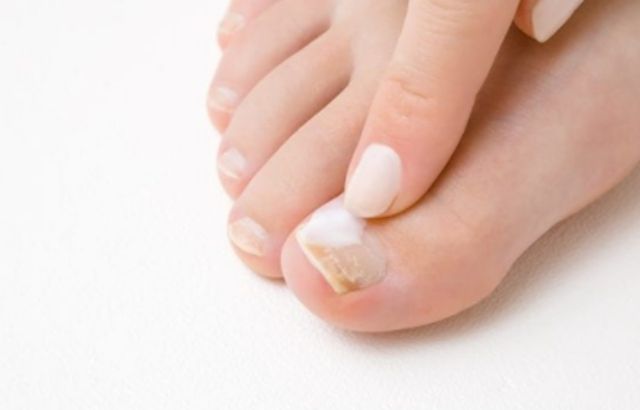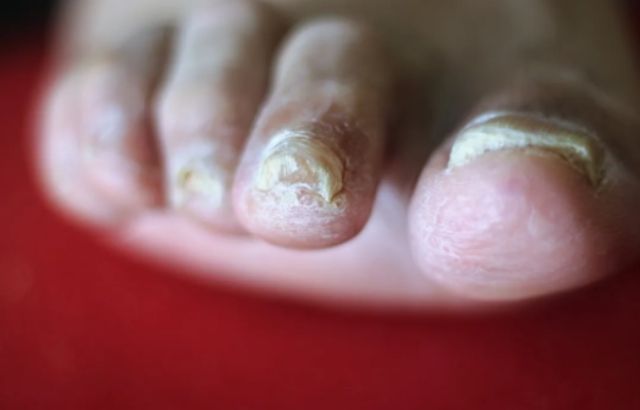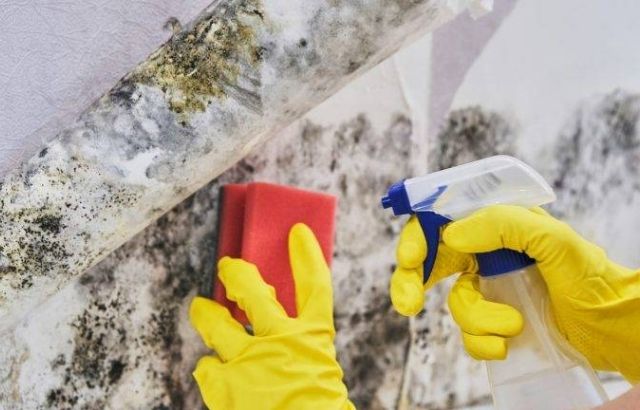Do you want to learn how to kill fungus with bleach?
Nail fungus is a taboo subject. Those who suffer from it want to keep the infection as secret as possible – often at the expense of quality of life. Nevertheless, nail fungus is common. Around ten to 30 percent of people worldwide are affected. The fungi mainly attack the toenails, less often the fingernails.
In many cases, onychomycosis, as doctors call nail fungus, is preceded by an athlete’s foot. The pathogens quickly get into the nail from the skin if the conditions are favourable for them. For example, if you injure your nail with a pair of scissors, fungi can enter the area. If nail growth is impaired by certain diseases or the immune system is weakened, the germs can also multiply. If a fungus lodges in the nail, it attacks the protein keratin, which strengthens the nails. They discolor and become crumbly. Anyone who suspects they might have a fungal infection on their nails would need this guide on how to kill fungus with bleach.
Causes of Nail Fungus
Onychomycosis is caused mainly by dermatophytes (a particular group of fungi) and sometimes by other fungi, such as yeast.
Fungi are microscopic organisms that like to live in hot, humid conditions. This is why people who swim or whose feet sweat a lot are more likely to have onychomycosis. Due to their very small size, fungi can invade your skin through a tiny cut or a small gap between the nail and the nail bed.
Onychomycosis affects the toenails more frequently than the fingernails because the toes are often confined to a hot and humid environment, i.e., shoes. Also, blood circulation in the toes is less critical than in the fingers; therefore, the immune system has more difficulty fighting off a foot infection.

Symptoms and Complications
- Onychomycosis can cause these manifestations:
- Discoloration of the nail that turns white, yellow, or brown;
- Thickening or lifting of the nail, or change in shape;
- Nail that breaks easily;
Painful Nail
Fungal nail infection usually does not cause a severe long-term problem if it is adequately treated; however, it can be more severe in some people. These include people with diabetes or those who have a weakened immune system and have difficulty fighting infections. If you notice any abnormal changes to the nails, it is still essential to see the doctor promptly for an evaluation, even if the infection is painless.
How to Kill Fungus with Bleach
Bleach can be a useful remedy for toenail fungus, but above all, we ought to ensure that there are no unpleasant side effects from using this powerful cleanser.
Sodium hypochlorite is usually used to clean and remove stains from clothes, sheets, and towels and is widely used to remove mold and bacteria. Given its remarkable antibacterial and anti-fungal properties, many people have started using a diluted bleach solution to treat nail fungus, called onychomycosis, and the athlete’s foot.
Suppose this nail pathology is not treated correctly in the initial phase. In that case, the fungal infection can worsen, and in the most severe cases, lead to onycholysis – total loss of the nail. To avoid this, many people look for all possible remedies to eliminate nail fungus, including using bleach.
On the other hand, treating toenail fungus with bleach without using the right precautions can be risky and lead to severe consequences.
Never use pure bleach in direct contact with the skin, as it is a detergent characterized by a strong caustic effect. If used improperly and recklessly, it can seriously damage the skin.
Do also note that it doesn’t matter if you use bleach with or without chlorine; the risks don’t change. It would help if you never immersed your feet directly in undiluted bleach, as this action could have many side effects such as:
- Skin inflammation
- Skin irritation
- Burning sensation in the feet or burns
- Permanent damage to the feet and surrounding tissues
- Itching
- Skin discoloration
If you experience any of these side effects after using bleach when treating toenail fungus, immediately rinse the treated area with the cleanser.
Instructions
Our feet, by the work they do, the socks and shoes we wear, and their constant sweating, are in danger of developing fungus around the fingers and under the toenails. Here are some steps to treat and prevent this common occurrence with bleach.
- Clip your toenails, being careful not to cut them too low.
- Soak your feet in a tub with coarse salt for at least 15 minutes. This will help keep your feet soft and healthy and should be done to prevent fungal growth. If you don’t have a bathtub, use a cake pan or plastic bowl of any kind.
- Soak your toes in bleach. While this sounds harsh, bleach is a potent agent that will soon kill the fungus and germs under your toes. If you are concerned about bleach damaging your feet, you can add bleach to water or a cotton swab to dab over the infected area, but make sure you have a generous amount on your toes.
- Soak your toes every night until the condition subsides. If not, you should consult your doctor.
How to Kill Fungus with Bleach Pen
Bleach pens can be used to remove toenail fungus – onychomycosis – of the foot. Usually, the bleach pen is used together with this anti-fungal cream to enhance its antimicrobial effect.

How do you use a pen?
The cap is removed and applied to the area to be treated. In most cases, it will be used directly under the toenails.
Bleach pens are readily available and very inexpensive. It is a safer remedy than diluted bleach and pastes solution as it contains a lower concentration of sodium hypochlorite. In case of excessive hypersensitivity or irritation, stop using this bleach pen immediately.
Furthermore, besides killing fungus, disinfecting surfaces with bleach and other disinfecting products is one way to help stop the spread of COVID-19, according to the Centers for Disease Control. If you are cleaning surface mold on a non-porous material, it is also fine (10% bleach in water).
Additional tips during treatments
To achieve maximum effectiveness during bleach treatments, you will need to prepare your toenails in advance. These little tips will improve bleach absorption and promote complete healing of toenail fungi.
- Try to keep the length of the nails normal; in fact, too long nails could make it difficult to absorb the bleach. Note: Do not use the nail clipper of your child or another person in your household as you could get infected with them.
- Unlike specific foot mycosis creams that have a relatively short time to take effect, to be successful with water and bleach treatments, you need to take a foot bath for at least 30 minutes a day.
- Take care of your feet and try to keep them dry at all times. Microorganisms proliferate in humid and wet environments. After a workout in the gym or after a good sweat, try to get rid of wet clothes quickly and treat yourself to a nice hot shower.
- Do not lend your shoes or use someone else’s.
- Spray your feet and toes with anti-fungal spray before putting on your socks every day.
- Wear clean socks and don’t wear socks for more than one day in a row.
- Wear well-ventilated shoes and if possible, take off your shoes regularly to allow the foot to breathe.
- Push back the cuticles that often cover the nails with the tip of the clippers. This allows the nails to grow smoothly as they should.
- In shared public spaces (like swimming pools or showers), wear shoes or sandals.
- If you have another medical condition, like diabetes, make sure you have it under control.
How to Kill Fungus with Bleach: FAQ Section
Will bleach kill a fungal infection?
As earlier highlighted, bleach will kill a fungal infection if appropriately used.
Will soaking feet in bleach kill fungus?
Soaking feet in bleach will kill fungus, though caution should be taken not to harm the feet.
What can you use to kill fungus?
All components of the fungus pathogen must be eliminated, down to the last spore. This is precisely the most common source of relapse and the number one reason most infections are persistent. In the case of severe infections of the nails, treatment is carried out with effective therapy that kills fungal spores, combined with well-tolerated internal treatment. The pathogen is thus gripped from the outside and the inside. Bleach (sodium hypochlorite) has a potent clinical formula that kills 99.9% of fungus, germs, and bacteria.
Further investigations found out that bleach is good but isn’t 100% effective. Thus, varnish, tincture, apple cider vinegar, olive leaf extract and tablets can also be used.
Contrary to popular belief, Virkon ® was found to be ineffective at disinfecting Mycobacterium tuberculosis at both 1% and 3% concentrations on hospital instruments and surfaces. It was also discovered that at 2%, 3%, and 4% concentrations, Virkon ® could not provide a good kill of mycobacteria. But mentally disabled the onset of growth, and was not recommended, mycobactericidal agent.
Conclusion
In conclusion, a nail fungus or onychomycosis is an infection caused by a fungus that reaches the toenails (in 80% of cases) or fingers and which gradually leads to its destruction. Most often, onychomycosis is caused by a dermatophyte that develops in a hot and humid environment. Thus, the feet’ sweat in closed shoes or activities in a humid environment such as swimming is particularly favorable to its development. Foot mycosis will not disappear in a single night as if by magic, but you will need to have a lot of patience and consistency in using these toenail fungus treatments highlighted above. Furthermore, treating the fungus early on will facilitate the elimination of the nail infection. When the infection has passed, try to maintain proper foot hygiene to avoid the appearance of mycosis again.




